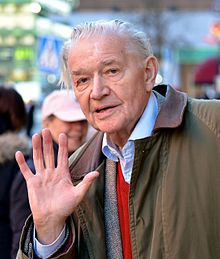Lennart Nilsson
Lennart Nilsson | |
|---|---|
 Lennart Nilsson in Stockholm, March 2014 | |
| Born | Lars Olof Lennart Nilsson 24 August 1922 |
| Died | 28 January 2017 (aged 94) |
| Nationality | Swedish |
| Known for | Photography |
| Notable work | A Child is Born (1965)
The Saga of Life (1982) Emmy awards in 1982 and 1996. Among others. |

Lennart Nilsson (24 August 1922 – 28 January 2017)[1] was a Swedish photographer noted for his photographs of human embryos and other medical subjects once considered unphotographable, and more generally for his extreme macro photography. He was also considered to be among Sweden’s first modern photojournalists.
Biography
Lennart Nilsson was born in Strängnäs, Sweden. His father worked at the railway as a repairman[2] and gave Lennart Nilsson a camera when Lennart Nilsson was twelve years old. When he was around fifteen, he saw a documentary about Louis Pasteur that made him interested in microscopy. Within a few years, Nilsson had acquired a microscope and was making microphotographs of insects.
In his late teens and twenties, he began taking a series of environmental portraits with an Icoflex Zeiss camera, and had the opportunity to photograph many famous Swedes.
He began his professional career in the mid-1940s as a
In 1954, eighty-seven of his portraits of famous Swedes were published in the book Sweden in Profile. His 1955 book, Reportage, featured a selection of his early work. In 1963 his photoessay about the Swedish
In the mid-1950s he began experimenting with new photographic techniques to make extreme close-up photographs. These advances, combined with very thin
In an interview published by PBS, Nilsson explained how he obtained photographs of living fetuses during medical procedures including laparoscopy and amniocentesis and discussed how he was able to light the inside of the mother's womb. Describing a shoot that took place during a surgical procedure in Göteborg, he stated, "The fetus was moving, not really sucking its thumb, but it was moving and you could see everything—heartbeats and umbilical cord and so on. It was extremely beautiful, really beautiful!" Nilsson also acknowledged obtaining human embryos from women's clinics in Sweden.[7] The University of Cambridge claims that "Nilsson actually photographed abortus material... working with dead embryos allowed Nilsson to experiment with lighting, background and positions, such as placing the thumb into the fetus' mouth. But the origin of the pictures was rarely mentioned, even by anti-abortion activists, who in the 1970s appropriated these icons."[8] However, Nilsson himself has offered additional explanations for the sources of his photographs in other interviews, stating that he at times used embryos that had been miscarried due to extra-uterine or ectopic pregnancies.
In 1969 he began using a
Around 1970 he joined the staff of the
Nilsson died on 28 January 2017.[9]
Awards and honors
Nilsson became a member of the Swedish Society of Medicine in 1969, received an honorary doctorate in medicine from
Nilsson's work is on exhibit in many locations, including the British Museum in London, the Tokyo Fuji Art Museum, and the Modern Museum in Stockholm.[18]
Since 1998, the Lennart Nilsson Award has been presented annually during the Karolinska Institute's installation ceremony. It is given in recognition of extraordinary photography of science and is sponsored by the Lennart Nilsson Foundation.
Works
Books
- 1959 Myror (Ants)
- 1959 Liv i hav (Life in the Ocean)
- 1963 Halleluja, en bok om frälsningsarmén (Hallelujah, a book about the Salvation Army)
- 1965, 1976, 1990, 2003 Ett barn blir till (A Child is Born)
- 1973 Se människan (Behold Man)
- 1975 Så blev du till (How You were Made)
- 1982 Vårt inre i närbild (Abbreviated version of Behold Man)
- 1984 Nära naturen. En upptäcktsfärd i naturens mikrokosmos (Close to Nature: An Exploration in Nature's Microcosm)
- 1986 I mammas mage (Being Born)
- 1993 Vi ska få ett syskon (We are Getting a Sibling)
- 2002 Hans livs bilder (Images of His Life)
- 2006 Life
References
- ^ "Världsberömde fotografen Lennart Nilsson död".
- ^ Släktingar.se (2017-02-25). "Fotografen Lennart Nilsson - västgötska bönder, valloner och skogsfinnar". Släktingar-bloggen (in Swedish). Retrieved 2022-11-26.
- ISSN 0261-3077. Retrieved 2019-11-18 – via www.theguardian.com.
- ISSN 0261-3077. Retrieved 2019-11-18 – via www.theguardian.com.
- ^ "See the First Photo That Let People See Life Before Birth". 100 Photographs: The Most Influential Images of All Time. Retrieved 2019-11-18.
- ^ Goldscheider, Eric (10 August 2003). "Fetal positions". Boston Globe. Retrieved 2 October 2009.
- ^ "NOVA Online/Odyssey of Life/Behind the Lens: Interview with Lennart Nilsson". www.pbs.org. Retrieved 2017-02-07.
- ^ As documented in Making Visible Embryos: http://www.hps.cam.ac.uk/visibleembryos/s7_4.html
- ISSN 0362-4331. Retrieved 2019-11-18 – via NYTimes.com.
- ^ Jaret, Peter (June 1986). "Our Immune System: The Wars Within". National Geographic. Vol. 169, no. 6.
- ^ Noske, Henning (2002-10-17). "Zeigen, wie ein Kind entsteht". www.braunschweiger-zeitung.de (in German). Retrieved 2022-05-18.
- ^ "PERSONNYTT: Nya hedersdoktorer". Dagens Nyheter (in Swedish). 2003-03-08. Retrieved 2022-05-18.
- ISSN 1542-0337.
- ^ "Utmärkelser och minnestecken 1919–2001" (PDF). Kungl. Ingenjörsvetenskapsakademien (in Swedish).
- ^ "Regeringens belöningsmedaljer och regeringens utmärkelse: Professors namn". Regeringskansliet (in Swedish). January 2006. Archived from the original on 2021-11-02. Retrieved 2022-05-18.
- SVT Nyheter(in Swedish). 2017-01-28. Retrieved 2022-05-18.
- ^ http://www.rps.org/about/awards/history-and-recipients/progress-medal Archived 2016-03-10 at the Wayback Machine Accessed 30 January 2017.
- ISSN 1101-2412. Retrieved 2022-05-18.
